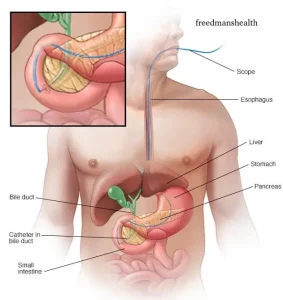Overview
Diagnosis of Ampullary Cancer
Ampullary cancer affects the ampulla of Vater, where the bile duct and pancreatic duct meet the small intestine. Diagnosis usually involves:
-
Medical history and physical exam: Your doctor will assess symptoms such as jaundice, abdominal pain, or unexplained weight loss.
-
Blood tests: Liver function tests and tumor markers like CA 19-9 may be checked.
-
Imaging tests: Ultrasound, CT scan, or MRI to locate the tumor and assess its extent.
-
Endoscopic procedures: Endoscopic retrograde cholangiopancreatography (ERCP) or biopsy can confirm the diagnosis by obtaining tissue samples.
Treatment of Ampullary Cancer
Treatment depends on the tumor stage, location, and patient health:
-
Surgery: Pancreaticoduodenectomy (Whipple procedure) is the primary treatment for localized tumors.
-
Radiation therapy: May be used after surgery or if surgery isn’t an option.
-
Chemotherapy: Used to shrink tumors, reduce recurrence risk, or manage advanced disease.
-
Supportive care: Nutrition support and pain management improve quality of life during treatment.
Key Takeaways
-
Early detection improves treatment outcomes.
-
Surgery remains the mainstay of therapy for resectable tumors.
-
Combination therapy may be required for advanced cases.
Advertisement

